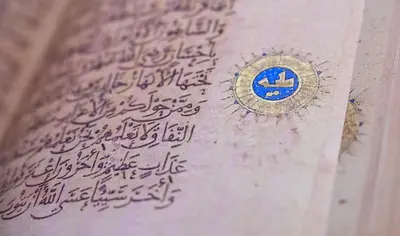Visitors at the 44th Sharjah International Book Fair (SIBF) are getting a rare chance to see a piece of Islamic art history — a facsimile edition of a Quran manuscript written more than a thousand years ago by the legendary calligrapher Abu al-Hasan Ali Ibn Hilal, widely known as Ibn al-Bawwab.
The beautifully reproduced manuscript is on display at the Safir Ardehal kiosk from Tehran, where visitors can witness the precision and beauty of early Arabic calligraphy.
“This is one of the oldest complete Quran manuscripts written by a known hand,” said Hamed Deshdashti from Safir Ardehal. “It’s a facsimile of the Quran originally written by Ibn al-Bawwab in 391 AH, around the year 1000 CE. The original copy is safely preserved at the Chester Beatty Library in Dublin, Ireland. What makes it special is that Ibn al-Bawwab was not just a calligrapher — he turned Arabic writing into an art of perfect proportion and spiritual beauty.”
Stay up to date with the latest news. Follow KT on WhatsApp Channels.
Masterpiece of proportionDeshdashti explained that the Quran is written in naskh script, a style Ibn al-Bawwab refined and perfected. Each page has 16 lines of neatly balanced text, with smooth letters, even spacing, and steady strokes. “In this Quran, you can see how every letter breathes within its own space,” he said. “Ibn al-Bawwab believed beauty lies in balance — every curve, every dot follows harmony and rhythm.”
Unlike earlier Quranic scripts that were square and angular, such as Kufic, Ibn al-Bawwab’s naskh style introduced fluidity and readability. “His lines flow like poetry. That’s why today’s Arabic calligraphy, from printing to design, still follows the same rules he created more than a thousand years ago.”
Written by one manDeshdashti added that the Chester Beatty Quran was likely written and decorated entirely by Ibn al-Bawwab himself. He not only copied the verses but also designed the gold decorations and chapter headings. “He was a perfectionist. The writing, the gold leaf, the floral borders — they all appear to come from the same hand,” he said.
The calligrapher used natural ink made from soot and gum arabic and a reed pen (qalam) cut at a precise angle, allowing him to write as well as create thin and thick lines in a single stroke. The text was written on vellum paper — a smooth surface made from animal skin, which helped preserve the manuscript for centuries.

“For visitors, this facsimile is more than an old book. It’s a window into history and craftsmanship. What you see here is pure human skill; no machine can reproduce the harmony between ink, line, and faith,” said Deshdashti.
The original Quran by Ibn al-Bawwab remains one of the greatest treasures of Islamic civilisation, kept under strict conservation at the Chester Beatty Library. “But having its replica here in Sharjah is equally valuable. It reminds us of the brilliance of Muslim artisans and how their art continues to inspire the world,” said Deshdashti.
Look: UAE experts bring centuries-old Quran back to life at Sharjah book fair How UAE experts bring rare, 1,200-year-old manuscripts 'back to life' Upside down map, Blue Quran: UAE exhibition shows Islam through ancient art, scienceYou may also like

Hailey Bieber lip-syncs, dances to husband Justin Bieber's hit song with BFFs Kendall, Kylie Jenner

'Masterpiece' film that fans say is the 'greatest thriller ever' is available on Amazon

PMK postpones caste census protest to Dec 12, calls for unity across communities

'Keep your salary': Angry employee's final message to boss goes viral

Drivers face £40 car tax rise from this date in 2026 Vehicle Excise Duty hike






